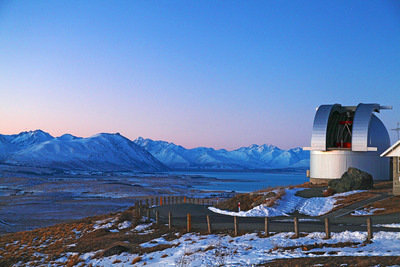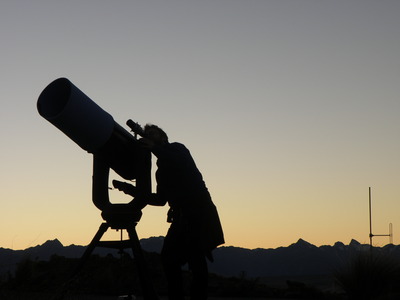CASE STUDY: On higher ground
Wednesday, 26 February, 2014
Better communications have improved safety management and efficiency for a New Zealand tourism operator that has a unique kind of business.
Between 17,000 and 20,000 visitors every year take a guided day or night stargazing tour at Mount John and Cowan’s Observatory. Located in the small township of Lake Tekapo in the heart of New Zealand’s South Island, the region is renowned for the clarity of its sky and freedom from light pollution.
Such popularity brings a high level of responsibility to ensure the safety of all visitors at every stage of the tour: from the bus trip to the summit, the cafe on the top of the mountain and throughout the night tour.
By installing a Motorola repeater and portable radios, operator Earth & Sky improved its health and safety risk management by providing continuous communications between head office, staff members and tour buses. Customer service has also improved, particularly in the pick-up service where tourists catch the courtesy bus to the peak.

The challenge
Earth & Sky started operations in 2004 and has flourished since. Tours take place on nearby Mount John, a large mass of bedrock 1031 metres above sea level and approximately 300 metres above Lake Tekapo. On the summit is the University of Canterbury’s Astronomical Research Observatory, internationally recognised as one of the best-situated observatories for viewing the southern night skies. Earth & Sky also operate the Astro Café on the summit, described by Lonely Planet as “possibly the best place on the planet for a café!”
Prior to the solution provided by Motorola Solutions, Earth & Sky relied upon portable handheld radios combined with mobile phones for its tours, buses, and in the main office.
Margaret Munro, general manager at Earth & Sky, describes the challenges of the existing communications system: “As the crow files, the office is very close to the summit. However, during the 15 minutes that it takes for the tour bus to reach the summit, for approximately half of that time the bus was completely out of range for communication. This is because the trip travels around the back of the hill so coverage was lost on both the radios and mobiles."
"Being unable to contact the team for this period of time was an occupational and safety issue if there was an emergency, or just difficult if plans changed or we needed to retrieve a vehicle for any reason. And we only had contact with staff on the mountain as long as they were within our line of sight.”
A local solution
The project included a base set in the office and new radios to communicate between the buses, office and the mountain. The equipment comprised: DP3400 VHF digital/analog portable radios, DM4400 Series digital radios and a DR3000 VHF. The repeater was installed on top of the observatory and extended coverage to the back of the mountain and Lake Tekapo.
Earth & Sky chose to partner with TL Parker, a family business formed in 1968 and now one of the largest privately owned two-way radio companies in New Zealand.
Munro found the experience of working with TL Parker extremely positive: “They really helped throughout the whole process over the last year, which included testing to see if coverage was possible in the area. They were personally very interested in the range achievable, as we are located in a basin.”
Chris Monson, astronomy guide and assistant manager at Earth & Sky, also had high praise for the team at TL Parker: “They … came out here frequently to sort out wear and tear or maintenance issues. They’ve also been very supportive in offering innovative solutions even though we are not a big organisation. For example, TL Parker suggested a number of novel ways to extend the capabilities of the radio units installed in the buses to allow our drivers to remain in constant contact with everyone, even if they temporarily leave the bus to attend to various customer-related services on the mountain top. They have always been keen for us to expand and try out new things.”

Reliability
“The best benefit from a business perspective is that the new system has removed any risk that might arise if there is an incident,” says Munro. "While it doesn’t prevent the incident from occurring, it means we’ve put measures in place to address them - measures that weren’t there before. This is a source of satisfaction for clients on the tour as well, knowing that they are being looked after at every step in the whole journey."
“It gives peace of mind,” adds Monson "In all aspects, it has elevated customer safety and provided the assurance that we are always there for the customer regardless of what happens. Recently we had the great snowstorms that knocked out towers, however, radios were still functional so we could send someone up to start clearing the road. You need to know you can manage the risks and contact someone before you send them up the mountain, and we could."
An immediate benefit was gaining complete and reliable coverage of Tekapo. Munro reports that the solution brought “complete coverage that was reliable and didn’t drop out, with exceptional quality. We now have contact with all staff at all times,” he says.
“Radios are more discreet [than mobile phones] as they use them with Motorola earpieces, connected to a microphone attached to the lapel,” says Monson. “The earpiece cuts down on wind, so staff spend less time battling against the wind. Your own message may be a bit garbled because of the windy background but the response from the office or buses is clear.”
“In addition, on a mobile phone you need to fiddle with all sorts of menus to get the required number, but with radios you simply switch between channels. You know that your message gets through and it makes your involvement with the equipment much more efficient,” concludes Monson.

A major benefit for customers is the improved bus pick-up service that Earth & Sky offers from local accommodation spots.
“The bus can arrive and there may be more people at the stop than planned because of ad hoc attendees, as well as booked parties. If there are too many people to fit in the bus, we used to rely on spotty service on a mobile phone to call a backup or, alternatively, ask the customers to wait for the next bus which was only dispatched when the driver arrived back at the base.”
“Now this is completely streamlined, because the driver can contact base immediately and ask them to send another driver. We can assure customers that the next bus will arrive within minutes - which is a huge improvement,” says Monson.
Some unanticipated benefits for staff and customer relations have emerged from the change in gear.
When using mobile phones previously, Earth & Sky staff used to feel impolite using mobile phones in front of a group of people wanting to ask questions. Monson explains: “It’s about being professional. If you have told a tour group you’re going to educate and excite them for the next hour, it sends a mixed message if you are on the phone. You want to engage with the customer, but it’s easy to interpret a mobile phone call as personal. It’s therefore difficult to convey that it’s a business call and in the customers’ best interests.”
“Plus, the customers have been asked to refrain from using mobile phones on the mountain as white light disrupts the sensitive research telescopes at the observatory. It’s not ideal to ask customers to forgo mobile phone usage only to have our guides use them,” adds Munro.
With a variety of businesses in the area such as other tourism operators, farms and a power company, Earth & Sky is looking into the potential of selling channels on the repeater.
“As the region grows and develops we expect the repeater to become a valuable piece of equipment. This will be a significant cost saving if comes about, and it’s great to be the owner of it,” says Munro.
Wireless networks for mine management
Today's fleet management applications form the foundation for a future where driverless...
Wireless networks for mine management
Today's fleet management applications form the foundation for a future where driverless...
Interoperability for Tasmania's emergency services
Tasmanian police, fire and ambulance services can now communicate directly with each other,...



